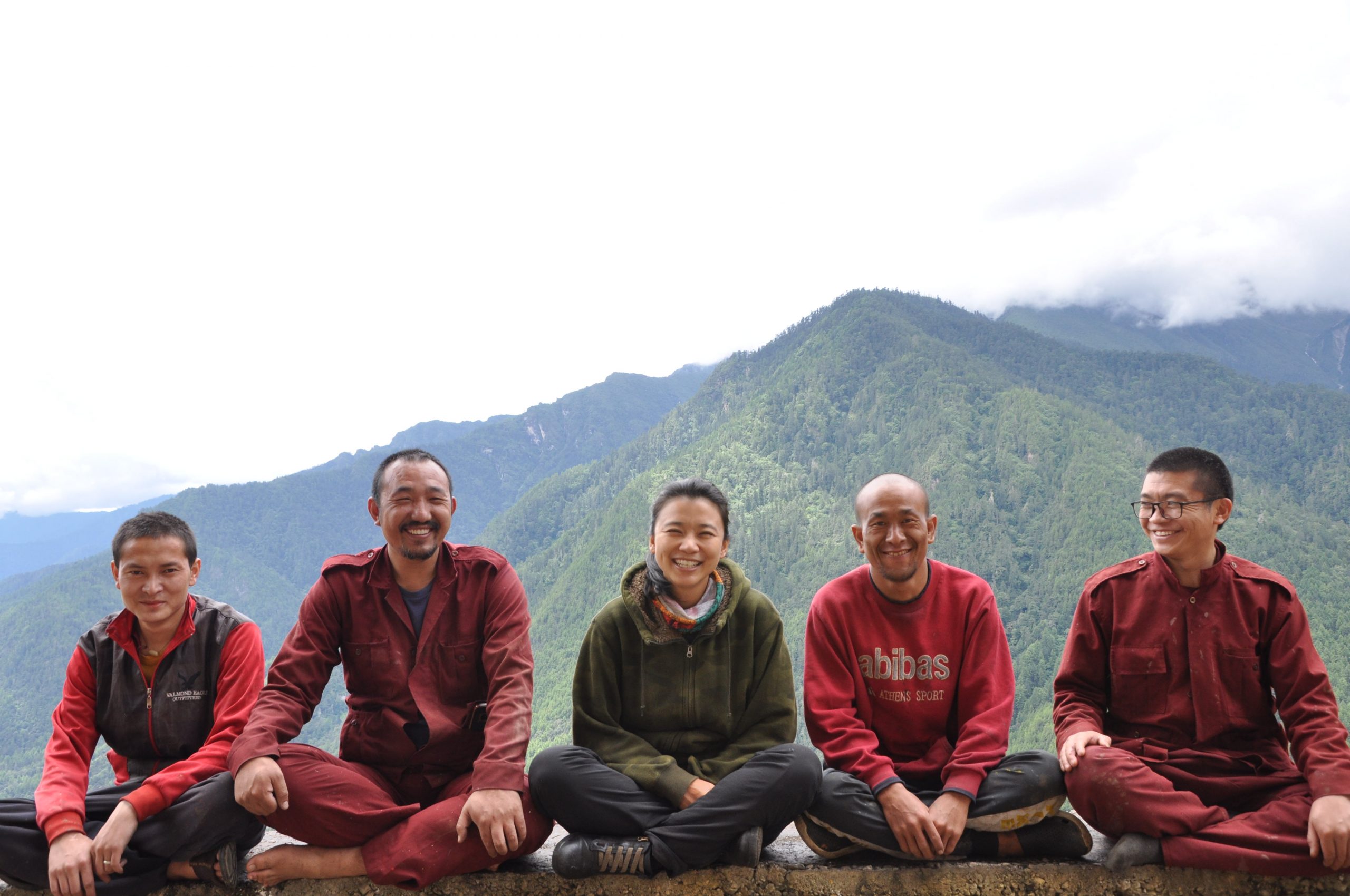
I’ve always admired Her Highness Ashi Kesang Choden’s passion for conservation. Fondly known as Ashi Baby Kesang, HH currently works as the Executive Director at the Bhutan Conservation office under the Central Monastic Body. She advises and looks after several conservation and restoration works for monasteries and temples across the country.
Following Her Highness’ Footsteps
Whether it’s in the way she talks about the restoration of an old mural, her enthusiastic participation in the menial tasks around the site or her spontaneous rapport with the monks working with her, you can tell how much her work means to her. On this incredible trip I followed the footsteps of HH as she took us on a journey. A journey delving into the history, significance of Buddhist arts and why protecting our cultural heritage is an imminent responsibility.
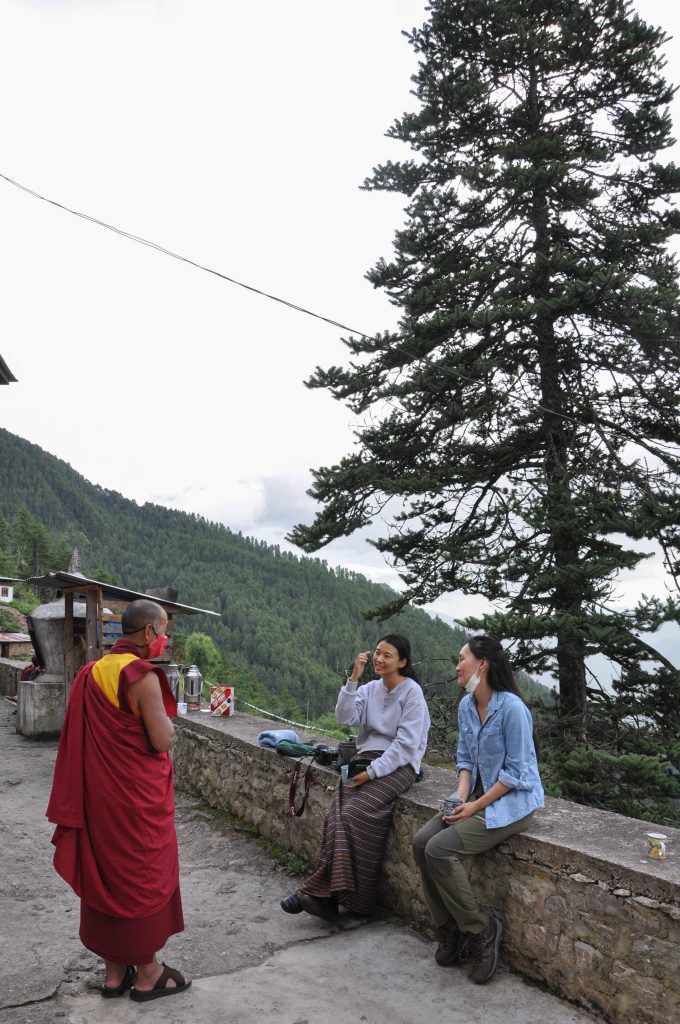
The Story of Lhading
Location: Lhading Monastery, Tsento, Paro
Lhading actually translates as the temple of the Flying Gods and Goddesses and this is its story. It is believed that some time in the 13th century, Tibet, Drogon Chogyal Phagpa, the 5th Sakya Patriach (1235-1280) prophesied that his disciples Drubthob Pawo Tagsham and Khandro Metho Seldon would build a lhakhang in Lhoring Ling (Bhutan). He then gave them a handful of blessed Na(Barley), saying “place this at the prophesied place.”
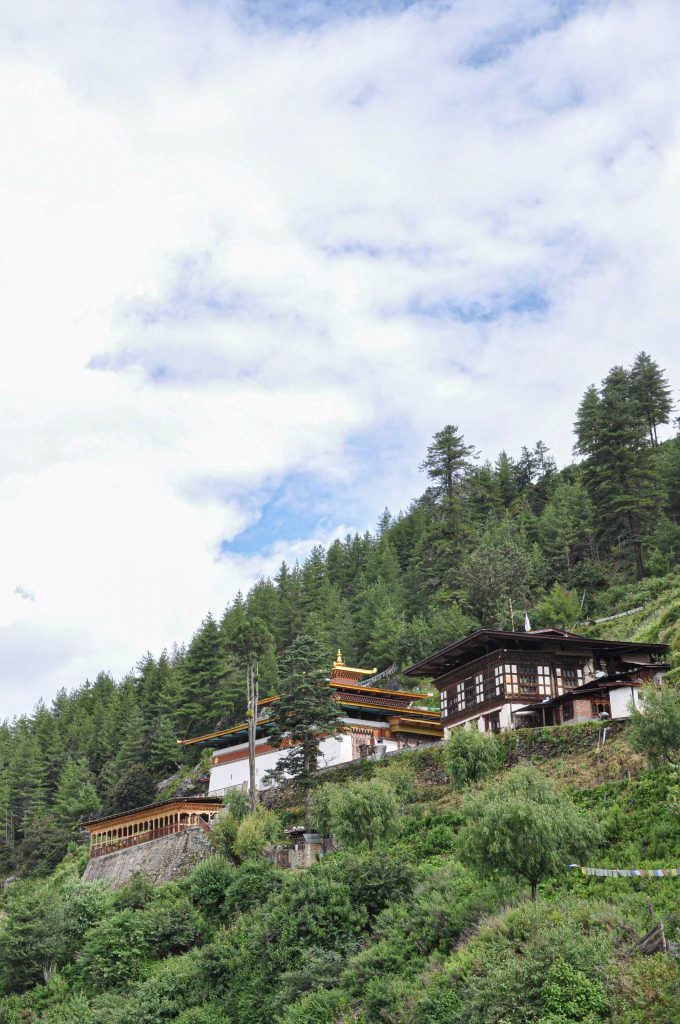
Following this prophecy, the Drubthob Pawo and the Khandro arrived from Tashi Lhunpo(sakya monastery), Tibet to Bhutan in the valley below present day Lhading monastery. There was an open meadow where they camped the night. At dawn, it is said that the Drubthob had a vision where he saw many gods and goddesses soaring in the skies above a spot. They soon proceeded down the valley, but the mule refused to go and instead started climbing up the mountain.
Taking this as a sign, they followed the mule up the mountain and arrived at present day Lhading Monastery, where there was a large lake with a cliff-face behind it. When the Drubthob saw the place, he realized it was the same place that he had seen in his vision that morning. They then prayed on the handful of Na(Barley) that was blessed by Drogon Phagpa, and sprinkled it in the lake. They spent the night there and in the morning found that the lake had receded and a piece of grassy mound had appeared. Taking this as an auspicious sign, they decided to build the prophesied monastery there.

It is said that the local guardian deity of the valley, Jowo Draktsen and the Tshomon(mermaid) of the lake brought the stones and wood, and assisted them(divinely) in the building of this sacred Goempa.
This sight of a mask peeping from a stupa frightened me the first time I saw it next to the temple. This is the wrathful guardian deity of the valley, Jowo Draktsen. It is believed that the deity walks along the creaking corridors of the Goempa in the middle of the night. For years I’ve listened to the stories of many guardian deities across Bhutan that protect their land but also punish those who dare desecrate it. As terrifying as some tales are, these supernatural elements show us a side of our people’s connection to our surroundings; rewarding if it’s tended to and catastrophic if not mask.
The Case of the Flying Relics
As is the rule at any other temple in Bhutan, we weren’t allowed to photograph the statues and the main Nangten (idol) in Lhading Goempa. But if you ever pay a visit, you’ll be told the story of the 10 flying statues that came here from Tibet.The main central relic is the Jowo Mikyo Dorji. On his right is a statue of a four-armed Avalokiteshvara (Chenrezig) and Vajrdhara (Dorji Chang), while on his left is a small statue of the wrathful deity Gye Tharched and Buddha Shakyamuni statue. Further left are the five wisdom Buddhas (Sangay Gye Wo Ring-nga).

Much later(15th C), it is said that the Five Wisdom Buddha statues started shaking, in order to fly back to Tibet. The 5th one flew back and as it did, a thundering echoing sound resounded the valley. The frightened Koenyer saw that the 5th one had flown and that the others were preparing to do the same. He is said to have run down the valley in a panic and found Drukpa Kinley making a stupa. Drukpa Kuenley is said to have sealed the 4 Buddhas to prevent them from flying away and built a replacement for the 5th one. However his statue became quite small and when he tried to remove it, it is said to have spoken, “I am alright.” And therefore it was left as it is.
Today, you’ll see the seal made by Drukpa Kinley on the statues and the smaller statue that spoke to Drukpa Kinley. It is amazing!

Restoration of Old Murals
After an amazing tour of the monastery, Her Highness went on to help the monks from her office working on the mural restoration inside Lhading Goenpa. Sitting on high wobbly ladders, donned in an oversized hoodie which she refers to as her “work clothes”, she takes a brush and starts painting on the images, filling the broken gaps of the ‘debri’ (mural). “Do you paint over it and make it completely new?” I ask. “We only do a light touch-up. For a conservator, the work is to preserve and assure the continuity of the piece itself instead of replacing it with something new.”
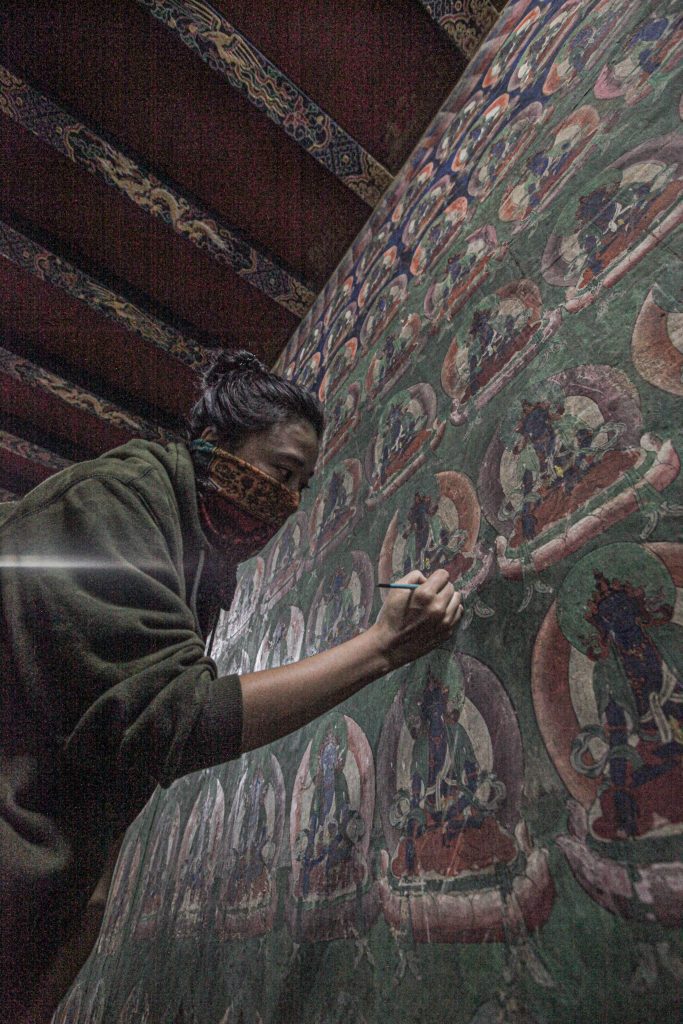
HH shares that the Bhutan Conservation office’s mission is to cultivate Buddhist values through conservation, imparting and study of both tangible and intangible aspects of the Buddhist heritage of Bhutan and the Himalayan region. And here are some new things I learned:
1. Conservation is prolonging the existence of an object through minimal maintenance.
2. Preservation: All preventive actions taken to maintain an object in its existing condition, to minimize the rate of change and/or slow down further deterioration and/or prevent damage are part of preservation. (Eg: storage, handling, etc)
3. Restoration: Involves actions taken to modify the existing material and structure of an object to restore it to a condition that is close to the (assumed) original. It is a treatment method used for conservation of an object.
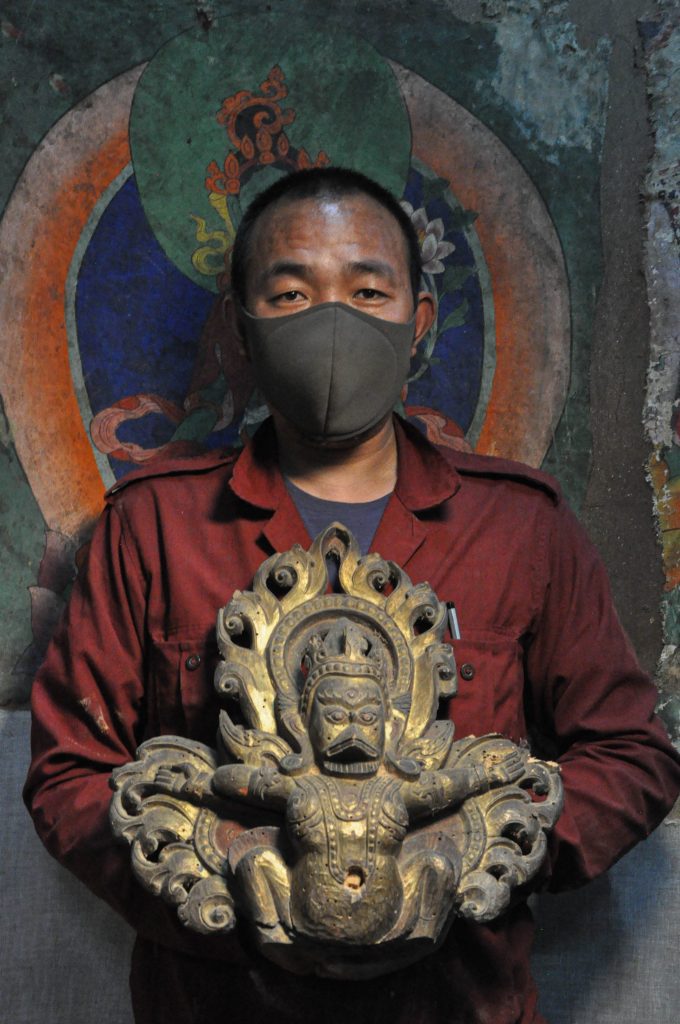
THE MYSTERIOUS ARTWORKS OF LHADING
As you make your way through the dark corridors of Lhading, you’ll come across broken pieces of wood work tucked in dark glass-encased shelves on your right. These ancient pieces of wooden carvings are broken fragments of throne jabyoe (back boards) designed behind the statues.
“These could not be restored as they have been damaged over the years by insects and the wood is already flaking,” says Her Highness as she points at the tiny black holes on the intricate carvings. She also adds that the people who worked on the renovation earlier almost threw it away because they couldn’t be restored. “We’ve had a lot of cases of sacred art work being burnt as people didn’t realize their worth. At least now people visiting Lhading can see these special art works during their pilgrimage.”

But the style of this specific artwork is unlike anything I’ve seen in most Lhakhangs (from my little experience) Her Highness tells me that because there isn’t any documentation of the Drubthob who built the temple, it’s difficult to point out exactly who and when these were created. The carvings of the animals and the Garuda bear closer resemblance to the ancient stone carvings in the temples in India. I’m no expert so I personally can’t give you more than that.
I soon find Her Highness sitting on the stairs corresponding with some experts online. She then excitedly shares that it was probably the 7th Sakya Trichen Chogyal Phagpa who came here from Tibet to consecrate the monastery. “We suppose that it was him because his artist was a Nepali, a Newari Artist called Araniko. By looking at the artwork and the information we got, Araniko vowed to be a Sakya monk after which he left for Mongolia. He was then introduced to Kublai Khan. Later he (Araniko) is also said to have built the famous white stupa in Beijing. We think that either himself or if not his Newari art disciples might have come here and done this. But We still need to corroborate the information by looking at some of the Namthar and biographies to confirm.”

If you ever get to listen to Ashi Baby Kesang talk about conservation, you’ll hear the name Ephraim Jose.
“Eddie had initiated a Thangka Conservation Workshop with Zhung Dratshang in early 2000s. The Dragon’s Gift Exhibition at the time had led to a number of conservators from the Honolulu Academy of Arts, Hawaii, USA, coming to Bhutan and training a number of monks from Zhung Dratshang. The only one that continued to persevere, despite many challenges, was the thangka conservation studio.
Eddie was looking for someone to help him with administrative and management of the studio and eventually, ofcourse, the handing over of his works to a good set of monk conservators. I only knew Eddie as a family friend, this flamboyant personality from the Philippines whose father had been good friends with Ashi Tashi Dorji (Her Majesty’s older sister) during the Colombo Plan and its involvement in Bhutan’s early development to modernization.
I had joined for a tea at Her Majesty’s and Eddie shared that there was no one to help him. Her Majesty looked at me and asked me to help him. I was a bit hesitant as I had never worked at an office before. So I joined mid May 2013. Let’s just say the monks were very surprised to say the least!” “I don’t think the conservation projects would be successful had it not been for the amount of time, resources and commitment Eddie put in it. We have a lot to be thankful for.”
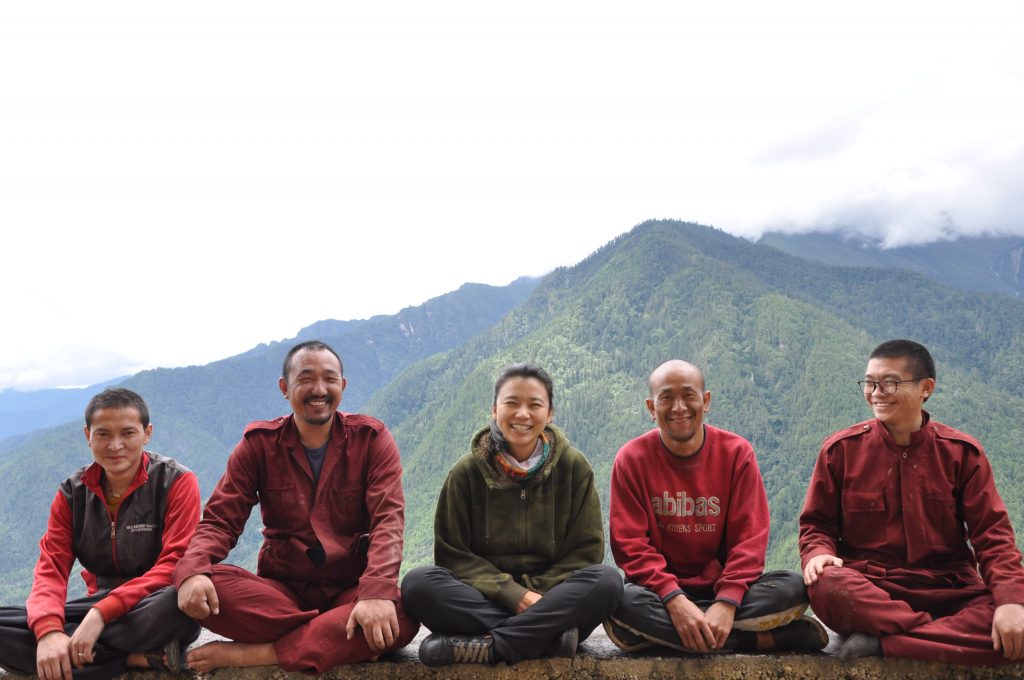
For more on Her Highness’ conservation projects follow her on instagram @bhutan_conservation